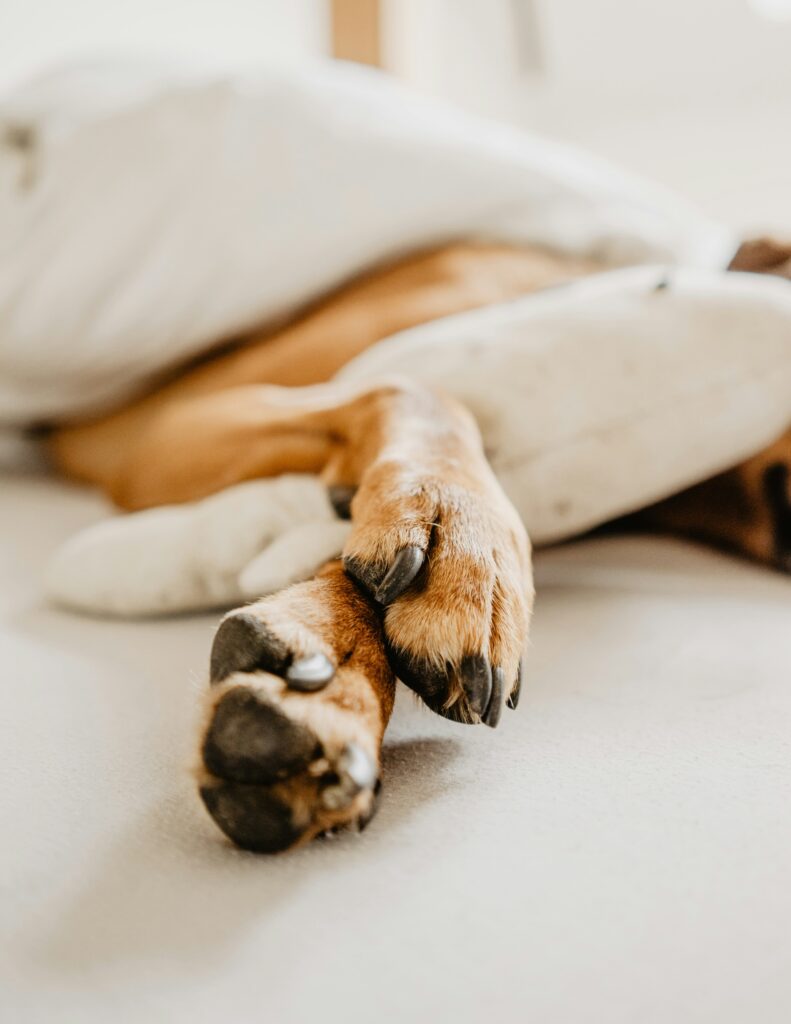Dogs’ expressive eyes, ears, and tails often get most of the attention, but their paws deserve recognition too. These complex and uniquely adapted appendages are integral to a dog’s daily activities, supporting everything from brisk trots to agile leaps. Whether delicate, sturdy, or furry, dog paws reveal fascinating details about a dog’s adaptability, health, and environment.
Here’s a look at 18 interesting facts about dog paws:
Shape and Size
- Paws Built for Cold Climates
Breeds from colder regions, like St. Bernards and Newfoundlands, have larger paws to help them walk more easily on snow and ice. These big, broad paws increase surface area, providing traction on slippery terrain. - Webbed Feet for Swimming
Breeds like Newfoundlands, Labrador retrievers, and Portuguese water dogs are known for their webbed feet, which make them natural swimmers. - “Cat Feet” for Endurance
Some breeds, including Akitas and Dobermans, have what’s known as “cat feet”—compact, round paws that use less energy to lift, improving endurance. These paws leave round, compact prints. - “Hare Feet” for Graceful Movement
Other breeds, like greyhounds and Samoyeds, have “hare feet,” where the middle toes are longer than the outer ones, creating a more slender, elongated print. This adaptation aids graceful strides and agility.

Anatomy of the Paw
- What’s in a Paw?
Of the 319 bones that make up a dog’s skeleton, several are dedicated to the structure of their paws. Each paw is a complex combination of skin, bones, tendons, ligaments, blood vessels, and connective tissues. - Five Essential Parts of a Paw
Each dog’s paw contains five major components: claws, digital pads, metacarpal pads, dewclaws, and carpal pads. These structures provide protection, support, and mobility.
Pads
- Shock Absorption and Traction
The digital and metacarpal pads cushion the bones and joints, acting as shock absorbers during high-impact movements. Carpal pads on the forelimbs function as “brakes” for dogs, helping them grip on slippery surfaces or steep slopes. - Temperature Regulation
Paw pads have a thick layer of fatty tissue that insulates against extreme temperatures. This adaptation likely developed as dogs evolved in colder environments. However, extreme heat or cold can still cause injuries, such as blisters in summer or cracked pads in winter. - Rough and Smooth Terrain Adaptation
Dogs accustomed to rugged terrain develop tougher, thicker pads, while those that mostly stay indoors or walk on smooth surfaces have softer pads. These pads also aid dogs in distinguishing between different types of surfaces. - Sweat Glands
The inner layer of paw skin has sweat glands, although they don’t cool the dog effectively. Instead, moisture excreted from these glands often leaves paw prints on the floor, similar to how human palms sweat.
Toes and Digitigrade Walking
- Digitigrade Walking
Dogs are digitigrade, meaning they walk on their toes rather than their heels. This anatomical adaptation places the weight on the toe bones, which plays a significant role in how they move and run. - Finger-to-Toe Equivalence
A dog’s toes are similar to human fingers and toes, although they lack the same dexterity, so they can’t wiggle them as freely as we can.
Dewclaws
- Vestigial Thumbs
Dewclaws, often present on the front legs and occasionally on the back, are thought to be remnants of thumbs. Dewclaws on the front limbs contain bone and muscle, but back ones typically have neither and may be removed to prevent snagging. - Gripping Assistance
Dewclaws aid dogs in gripping objects such as bones and toys. They also provide extra traction when dogs are running at high speeds or making sharp turns. - Double Dewclaws in Certain Breeds
Some breeds, like the Great Pyrenees, use rear dewclaws for stability on uneven terrain. Show breeds such as the Beauceron and Pyrenean shepherd often have double rear dewclaws as part of their breed standard.
Paw Odor and Care
- The “Frito Feet” Phenomenon
If you’ve noticed a corn chip-like smell emanating from your dog’s paws, it’s due to natural bacteria and fungi on the skin. This “Frito feet” smell is generally harmless and doesn’t lead to complications. - Paw Massage Benefits
Like humans, dogs enjoy a good massage. Rubbing between the pads and each toe can relax your dog, improve circulation, and ease tension in their paws.
Etymology
- The Origin of “Paw”
The word “paw” comes from the 14th-century Old French term powe, meaning the foot or hand of an animal with claws or nails.
From temperature-regulating pads to webbed feet for swimming, dog paws are marvels of evolution and adaptation. These fascinating structures support dogs in all their activities, providing them with the grip, traction, and resilience they need to thrive in diverse environments. So next time you see your dog sprint, jump, or simply rest, take a moment to appreciate the wonder of their paws.




